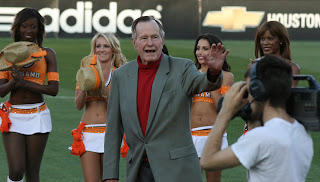 Sporting events in the United States are unlike anywhere else in the world. The glitz, razzmatazz, pyrotechnics, cheerleaders, kiss-cams on big screens, the incessant corporate plugs during breaks in play, the observing of the national anthem sung with gusto by a wannabe celebrity. It’s all part of American kitsch woven into the country’s fabric that, as we Brits would say, is just not cricket.
Sporting events in the United States are unlike anywhere else in the world. The glitz, razzmatazz, pyrotechnics, cheerleaders, kiss-cams on big screens, the incessant corporate plugs during breaks in play, the observing of the national anthem sung with gusto by a wannabe celebrity. It’s all part of American kitsch woven into the country’s fabric that, as we Brits would say, is just not cricket.It is not my intention to criticise as I do enjoy some of the peripheral entertainment and appreciate the different culture, but the bottom line is that when I go to see a sporting event, I go to see a sporting event. That is where my focus lies, where my interest is held, and if nothing else were to take place I would not care in the slightest.
Growing up in Scotland, attending a soccer match for me involved a few beers with the lads before the game, piling into the ground shortly before kick-off to give your team a roaring welcome, passionate involvement throughout the first half (no trips to the popcorn stand or candy floss stall required), fifteen minutes of further catching up on the previous night’s escapades with friends during half-time, then a second 45 minutes of fist-pumping dedication to the cause. Since the Sky era revolutionised the game in the early 1990’s, clubs have made token attempts to follow America’s lead with dance teams and half-time prizes but on a reduced scale. Not only is there a general lack of spectator interest, but our reserved manner means we simply do not do these things very well.
By contrast, Houston Dynamo have pulled out all the stops during the team’s two home Major League Soccer matches this year. The season opener against FC Dallas saw parachutists land in the centre circle (one dressed as Dynamo Diesel, the team’s mascot), fighter planes soar above the stands, a video message of support from former President George H.W. Bush and the unveiling of the Dynamo Girls’ new line-up and dance routine.
Mr Bush was back in person last Saturday evening to present the Dynamo players with Championship rings to mark last season’s title success. The cheerleaders were kept occupied with t-shirt giveaways, on-field presentations were made to successful local youth teams and a contestant from American Idol did the honours with the anthem. All was going to plan, until a series of unexpected explosions caused flutters in the crowd. Unfortunately the public were not alone in being caught out.
 It quickly became apparent that the person responsible for the fireworks display had been injured by a seemingly premature explosion. The gentleman unsteadily negotiated himself away from the centre circle before dropping to the ground clutching his face. His once-white shirt was discoloured by smoke and blood was apparent on his limbs. More blood streamed from his mouth as officials arrived to dowse the smouldering container and check on his condition. Paramedics arrived within minutes to stretcher the poor fellow away to a nearby medical facility, but despite this taking place on the field the event went unnoticed by most of the crowd who were paying attention to the ongoing festivities.
It quickly became apparent that the person responsible for the fireworks display had been injured by a seemingly premature explosion. The gentleman unsteadily negotiated himself away from the centre circle before dropping to the ground clutching his face. His once-white shirt was discoloured by smoke and blood was apparent on his limbs. More blood streamed from his mouth as officials arrived to dowse the smouldering container and check on his condition. Paramedics arrived within minutes to stretcher the poor fellow away to a nearby medical facility, but despite this taking place on the field the event went unnoticed by most of the crowd who were paying attention to the ongoing festivities.Thankfully, word seeping out from the Dynamo organisation over the weekend indicated that the man had been released from hospital on Sunday having sustained no major injuries. He was extremely fortunate.
A less serious incident occurred that same evening in New Orleans where the second quarter of the Hornets’ NBA basketball play-off match against San Antonio Spurs was delayed by 20 minutes. At the end of the first quarter, the Hornets’ mascot took to the court to jump through a ring of fire. Residue left on the floor by fire extinguishers resulted in an impromptu clean-up operation. Minutes after play resumed, Tim Duncan, the Spurs’ all-star forward, slipped in mid-court provoking further mopping up at half-time. Thankfully none of the players were hurt as a result of the briefly treacherous surface.
The popular school of thought among American franchises is that consumers are there to be entertained by whatever means available – the more extravagant, so much the better. Ultimately though, sports fans will leave the arena talking about the game itself, whether good or bad, and not the triple somersaults performed by the half-time trampolinist.
In light of the past weekend’s near misses, those organisations should be examining the potential risks of their sideshows and erring firmly on the side of caution. Placing the public or participants in harm’s way for the sake of a feel-good stunt must not feature on the agenda. Nobody in the audience would be remotely disappointed if providing a spectacle is left to their favourite athletes.



.jpg)